Commemorative Stamps
November – December 2013
Commemorative Stamps
Nevada has recognized its milestones through the years on various U.S. postage.
By THOMAS LERA
NEVADA FIRST SETTLEMENT CENTENNIAL
On October 3, 1945, Nevada Senator Pat McCarran wrote to Postmaster General (PMG) Robert Hannegan, suggesting the issuance of a commemorative stamp for the first post office established in the Territory and State of Nevada.
Within two weeks, McCarran met with Robert E. Fellers, director of the U.S. Post Office Department (POD) Stamp Division, and all of the details were worked out. However, things moved slowly. It was nearly six years later before Postmaster General Jesse M. Donaldson issued the three-cent Nevada First Settlement Centennial commemorative stamp.
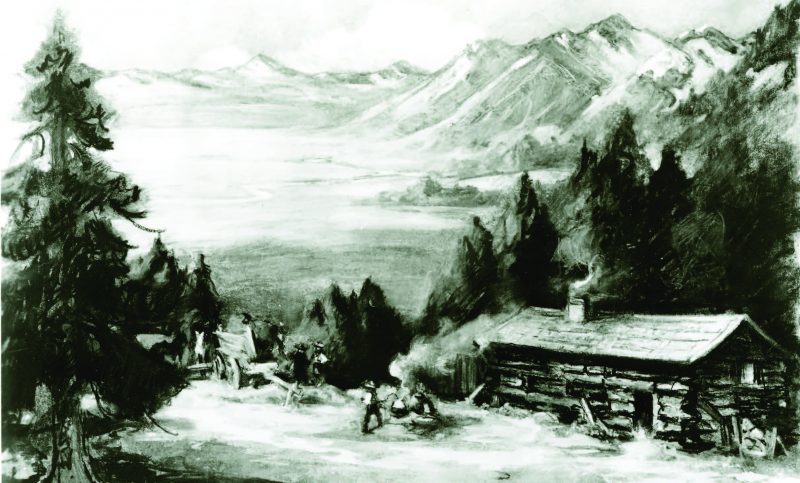 On June 18, 1951, Governor Charles H. Russell issued a proclamation marking July 14, 1951 as Nevada First Settlement Centennial Day, with a celebration to be held in historic Genoa. Assistant Postmaster General Osborne A. Pearson, representing Donaldson, gave a speech on the occasion.
On June 18, 1951, Governor Charles H. Russell issued a proclamation marking July 14, 1951 as Nevada First Settlement Centennial Day, with a celebration to be held in historic Genoa. Assistant Postmaster General Osborne A. Pearson, representing Donaldson, gave a speech on the occasion.
Pearson said, “The little settlement at Mormon Station, which later became Genoa, proved to be a lifeline to those early pioneers who pushed the frontier of the young nation westward.” The stamp’s design was taken from a pastel and tempera painting by Professor Hans Meyer-Kassel, once a Genoa resident. The stamp was printed on a rotary press and issued in sheets of 50.
Steven A. Kinsey and Colonel John Reese established Genoa, Nevada’s first permanent settlement, in spring 1851, when the men opened a trading post on the Overland Trail. They arrived in Carson Valley with 13 wagons loaded with eggs, bacon, flour, grain, and more and soon established a blacksmith shop, livery stable, and nearby flour and saw mills.
On November 12, 1851, the group formed a settlers’ or squatters’ government. They adopted rules for “taking up” land and elected Reese recorder and treasurer. In December 1852, Reese, a Mormon, recorded the first claim in the new Utah Territory settlement he named Mormon Station. Those who settled there traded produce to travelers for whatever was usable. The Post Office was established December 10, 1852 with the appointment of E.L. Barnard as postmaster.
In 1854, the Utah Territorial Legislature organized Carson County, Utah. Governor Brigham Young appointed Mormon Apostle Orson Hyde to serve as probate judge and spiritual head of the community. Hyde later changed the name of the community to Genoa (for Genoa, Italy) and made it the county seat.
Between 1856 and 1876, John A. “Snowshoe” Thompson delivered mail between Placerville, California and Genoa, and later Virginia City. Despite his nickname, he did not make use of the snowshoes native to North America, but rather traveled with 10- foot skis and a single sturdy pole generally grasped with both hands. He was never paid for his 20 years of service.
Genoa was a regular stop for the Pony Express during its 18-month heyday from 1860-61. Many famous people have frequented Genoa over the years, among them Mark Twain, presidents Ulysses S. Grant and Theodore Roosevelt, Kit Carson, John C. Fremont, and Captain James H. Simpson.
SILVER CENTENNIAL
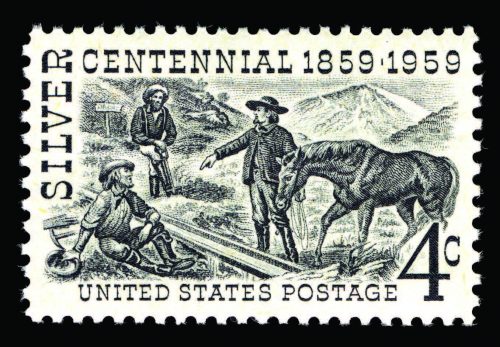 The Comstock Lode is one of the most important mining discoveries in American history and was the landmark event in 19th- century Nevada. The design of the Silver Centennial stamp suggested by Governor Russell and the Nevada Silver Centennial Committee was based on an early woodcut depicting Henry Thomas Paige Comstock, Peter O’Riley, and Patrick McLaughlin at the time of the discovery of the Comstock Lode.
The Comstock Lode is one of the most important mining discoveries in American history and was the landmark event in 19th- century Nevada. The design of the Silver Centennial stamp suggested by Governor Russell and the Nevada Silver Centennial Committee was based on an early woodcut depicting Henry Thomas Paige Comstock, Peter O’Riley, and Patrick McLaughlin at the time of the discovery of the Comstock Lode.
In January 1957, the State of Nevada passed Senate Joint Resolution No. 1 relative to the issuance of a centennial stamp in commemoration of the discovery of the Comstock Lode and mailed a certified copy to President Dwight D. Eisenhower and Postmaster General Arthur Summerfield.
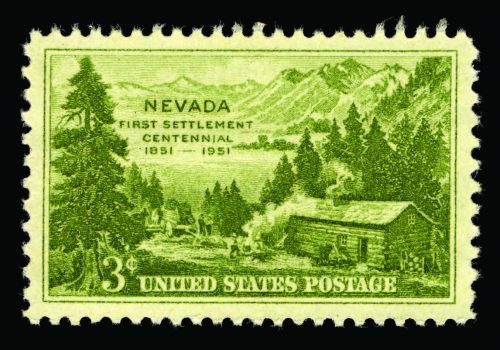
On November 22, 1958, after much back and forth between congressman and legislators, the Nevada Silver Centennial Committee learned their request for a silver centennial stamp had been denied.
Two weeks later, on December 16, 1958, Nevada Congressman Walter Baring wrote to Rohe Walter, special assistant to the PMG. Baring reminded Walter of the past Nevada State Legislature requesting the PMG issue a commemorative centennial stamp recognizing the discovery of the Comstock Lode. He also attached U.S. Senate Concurrent Resolution 52, passed by the House and Senate in August 1958, congratulating Nevada citizens and the Nevada Centennial Committee upon the occasion of their commemorative celebration on the 100th anniversary of the first significant discovery of silver in the United States.
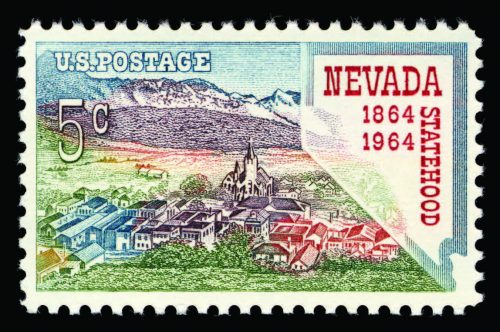
Almost two months later, on January 23, 1959, Walter called Senator Allan Bible to inform him the request for a stamp had been denied. The Nevada political machine flexed its muscles, and the POD ultimately reversed its decision. In an April 30, 1959 letter to Walter, new Nevada Governor Grant Sawyer thanked him for his letter of April 23 announcing the Silver Centennial Stamp would be issued in Virginia City on June 8, 1959.
There were several proposed designs leading up to the final version by Robert L. Miller and W.K. Schrage of the Bureau of Engraving and Printing. The stamp was printed by rotary process in shades of black and white to simulate the color silver.
NEVADA STATEHOOD CENTENNIAL
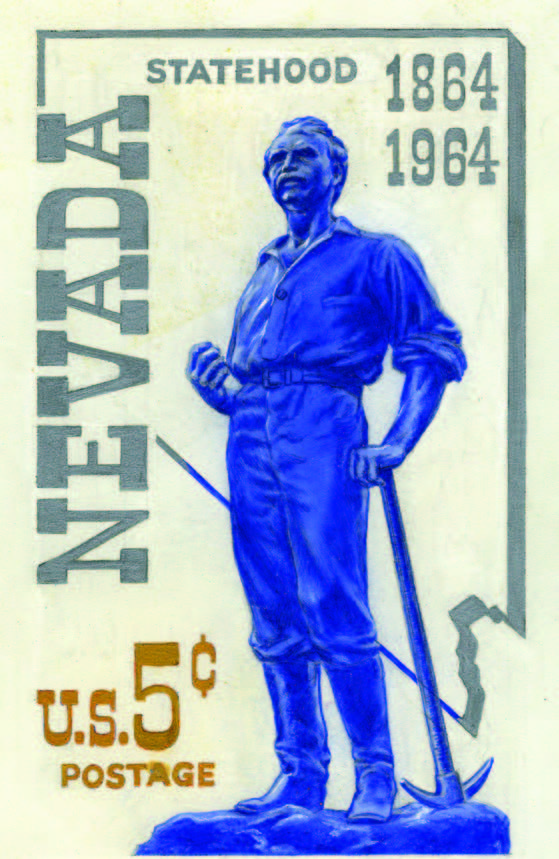 Throughout Nevada’s early years, the Postal Service followed the wagon trains and mining wagons westward. In 1860, Carson City became the permanent territory/state capital and an authorized Pony Express station. On April 12, 1860, when a Pony Express rider brought mail and dispatches from St. Joseph, Missouri, Carson City telegraphed the news onto California. Communication, the lifeline of progress, now spanned the continent.
Throughout Nevada’s early years, the Postal Service followed the wagon trains and mining wagons westward. In 1860, Carson City became the permanent territory/state capital and an authorized Pony Express station. On April 12, 1860, when a Pony Express rider brought mail and dispatches from St. Joseph, Missouri, Carson City telegraphed the news onto California. Communication, the lifeline of progress, now spanned the continent.
In 1864, three Congressional votes were needed for the necessary two-thirds vote to pass the 13th Amendment abolishing slavery. The divided nation needed another Free State to ratify its constitution, so President Abra-ham Lincoln looked anxiously to the Territory of Nevada. Nevada became the 36th state on October 31, 1864, and three months later Congress passed the 13th Amendment.
Skip ahead nearly a century, and Nevada was approaching an important anniversary. On March 2, 1960, Nevada transmitted to President Eisenhower a copy of Nevada Senate Joint Resolution No. 3, requesting the POD issue a commemorative stamp in honor of Nevada’s 100th anniversary of admission into the Union. A year later, on March 8, 1961, a similar Senate Joint Resolution No. 3 was sent to newly elected President John F. Kennedy. The White House forwarded both resolutions to the POD.
PMG J. Edward Day visited Reno in June 1962. He met with the chairman of the Nevada Centennial Commission, Effie Mona Mack, whom he assured a commemorative stamp for the Centennial would be issued. Upon receiving this assurance, comprehensive plans were begun for a celebration of Nevada’s centennial in 1964.
The Nevada Commemorative Centennial Stamp Committee suggested a design for the four-cent stamp unaware the Post Office would raise the first-class postage rate to five cents on January 7, 1963. In an April 18, 1963 letter to Day, Governor Sawyer made a formal request to issue a Nevada Commemorative Centennial Stamp; he also sent one to Sidney Bishop, acting PMG, restating this request. He suggested the stamp be issued on Lincoln’s Birthday and that the iconic president’s image be used.
On September 9, 1963, Thomas Wilson, Chairman of the Nevada Centennial Commission, suggested the design of “The Lone Indian” on horseback in the “End of the Trail” pose. The drawing also featured a globe with Nevada highlighted and a native yucca plant in the lower right corner.
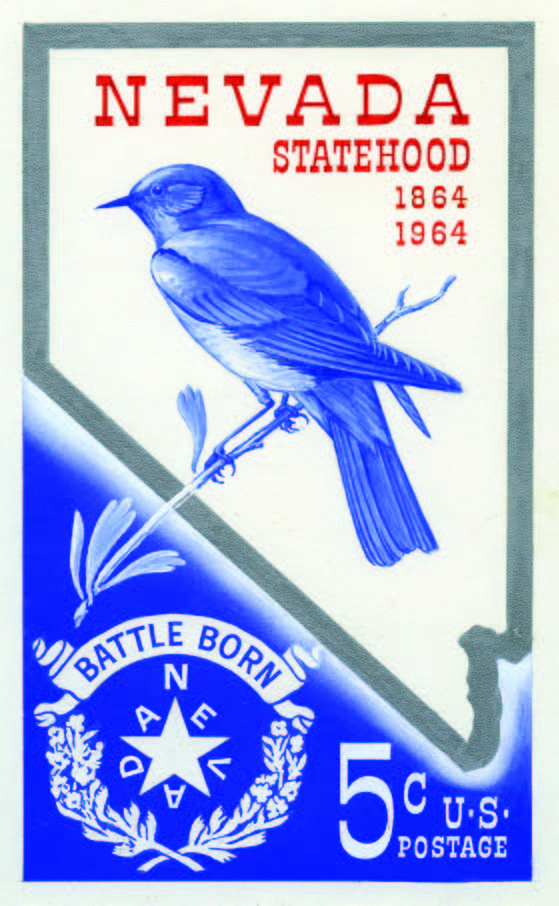 Michael Monroney, executive assistant to PMG John A. Gronouski, wrote Senator Bible on November 18, 1963, advising him the stamp would be issued in Carson City on Lincoln’s birthday (February 12, 1964) if the design could be approved within two months. Later, the Bureau of Engraving and Printing artists suggested several designs including an outline of a map of the state, the Capitol, the emblem from the state flag, the state bird (mountain bluebird), the state flower (sagebrush), mining symbols, and even Mark Twain. These proposals are still in the PMG’s collection.
Michael Monroney, executive assistant to PMG John A. Gronouski, wrote Senator Bible on November 18, 1963, advising him the stamp would be issued in Carson City on Lincoln’s birthday (February 12, 1964) if the design could be approved within two months. Later, the Bureau of Engraving and Printing artists suggested several designs including an outline of a map of the state, the Capitol, the emblem from the state flag, the state bird (mountain bluebird), the state flower (sagebrush), mining symbols, and even Mark Twain. These proposals are still in the PMG’s collection.
On the same day, Baring wrote “at the time of PMG Day’s resignation, all of the arrangements to issue the stamp at Carson City on February 12 were on schedule. The information I received this morning assured me all appropriate Washington officials had approved the stamp and final approval was on the PMG’s desk for signature. Dr. Effie Mona Mack heard, either officially or unofficially, the issuance of the stamp was being held up…Please advise me if there is at this time any hitch which would affect the efforts of Centennial Stamp Committee.”
Gronouski wrote Congressman Baring on November 18 explaining, “The stamp design would be unveiled on Lincoln’s birthday and is scheduled to be issued at Carson City. Some- time in April 1964 we will set the date for the ceremony.”
After the unveiling ceremony on February 18, 1964, Reno Postmaster E.J. Arch wrote, “Since the announcement and publishing of a photograph of the commemorative stamp honoring Nevada’s centennial, there have been several ‘complaints’ made by citizens who state the scene depicted of Virginia City in the proposed design is incorrect. The so-called complaints are basically resolved to the fact that the depicted scene is in reverse to actuality. The scene was incorrectly published in the Vacation Guide to Nevada. The POD made it clear in its explanations the design merely typifies an old-time Nevada community, and there was no intention to identify the scene with any actual location.”
Finally, on July 22, 1964, five months after Lincoln’s birthday, Tyler Abell, assistant PMG representing President Lyndon B. Johnson and Gronouski, issued the stamp in Carson City. It was printed on a Giori press designed to print three colors from a single plate by applying ink to separate parts of the design with three rollers. The three colors used were red, yellow, and blue, which—by the use of the bleeding technique—created green, brown, and purple, resulting in six distinct colors.
It took 19 years and the involvement of four presidents, two governors, seven senators, four congressmen, the Nevada Centennial Committee, and countless Nevada residents working with four different postmaster generals to issue three commemorative centennial stamps recognizing the accomplishments of the Battle Born State.

